GENERAL
INFORMATION
Terminology & Properties
 Home
GENERAL INFORMATION
Terminology & Properties
Home
GENERAL INFORMATION
Terminology & Properties
Terminology
With precise, moving parts, designed and manufactured to bear definite relationship to one another, Wire Rope can be a complex mechanism.
Wire rope is generally composed of wires, strands and the core (See Fig.). The wires are helically laid together in a precise geometric pattern to form the strand. The strands helically laid about the core to form the wire rope. The process of positioning the strands about the core is called “closing”. The process of positioning the wires within the strand is called “stranding”.
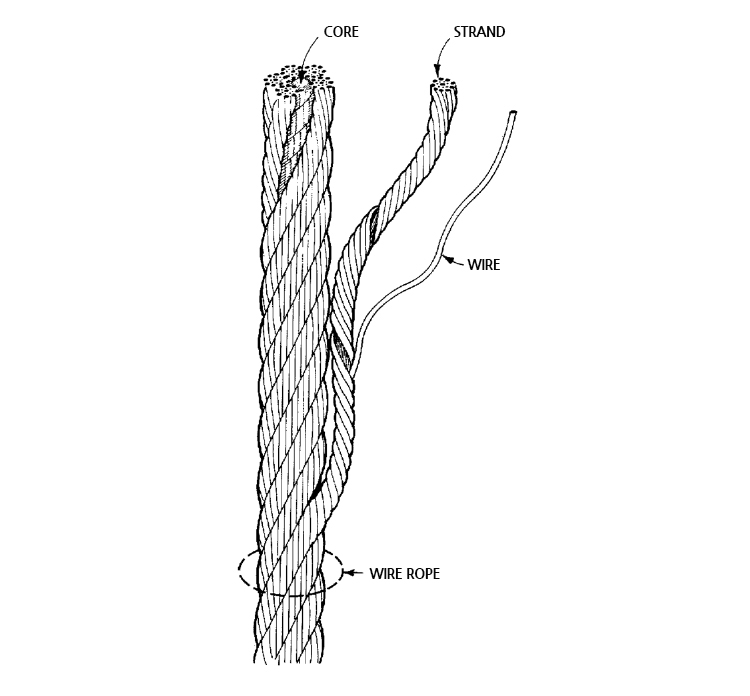
Wire rope varies:.
• By Diameter
• The grade of steel utilized
• The direction of stranding and closing
• The finish on the wire (Bright, Galvanized, etc.)
• The core material
Each variation changes the performance characteristics of the wire rope.
The first differentiation of wire rope is by diameter. The diameter is measured at the diameter of the circle formed by
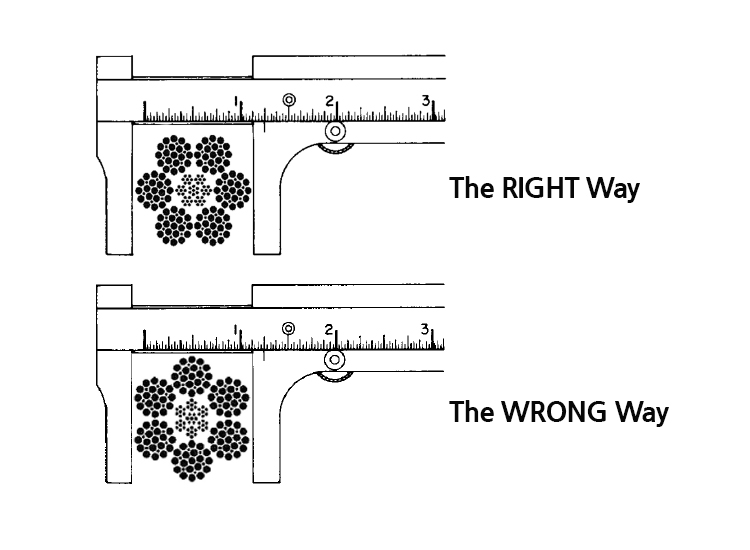
the extreme outer dimensions of the strands. (See Fig.). New wire rope is manufactured to an oversized diameter of approximately 2-1/2%. This allows for the normal reduction of diameter experienced when a new rope is placed under load because of constructional stretch.
CAUTION: At NO time should the measured diameter be less than the nominal diameter of the wire rope.
The grade of steel (or other material) utilized in the construction
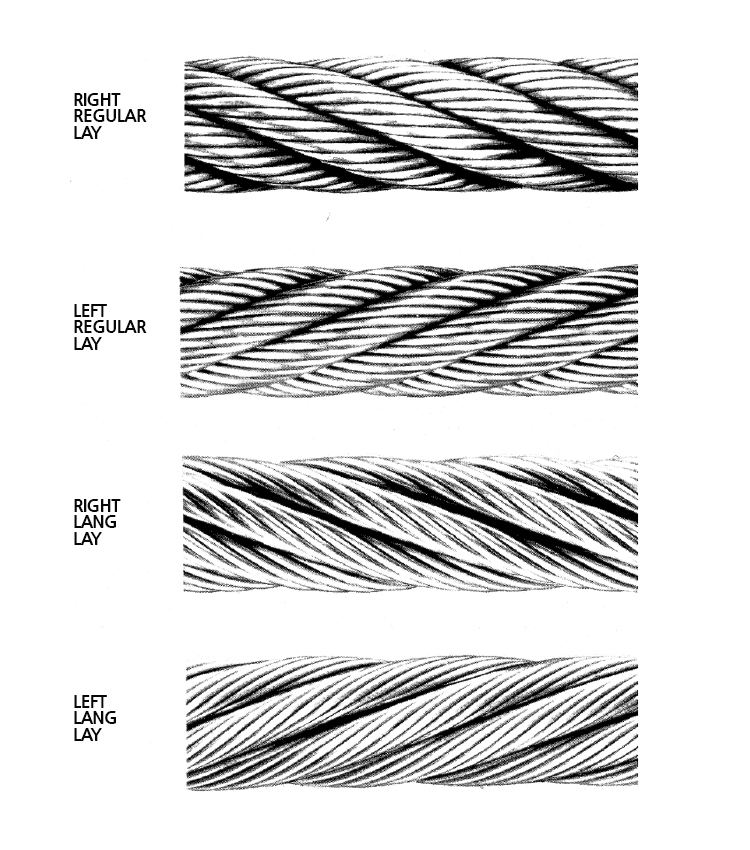
construction of the wire rope has a major influence upon the ultimate break strength. Generally most steel wire rope today is at Improved Plow Steel Grade or IPS. In recent years Extra Improved Plow Steel (EIPS) wire rope has gained in popularity and is approximately 10% stronger than IPS. Manufacturers have begun producing limited constructions of Extra Extra Improved Plow Steel (EEIPS), which is 10% higher than EIPS grade. Some special constructions exceed EEIPS grade.
The “Lay” of the wire rope (the direction of stranding and closing) directly affects the operating properties. In Regular Lay wire rope, the direction of the wires are twisted in an opposite direction than the direction of the strands. Regular Lay may be Right Regular Lay or Left Regular Lay depending upon the direction of the strands. (See Fig.).
In Lang Lay wire ropes the direction of the wires are twisted in the same direction as the strands. Lang Lay may be Right Lang Lay or strong>Left Lang Lay depending upon the direction of the strands. The wires of a regular wire rope seem to travel parallel and along the length of the rope while those of a lang lay rope appear to travel around the rope.

In addition, the Lay Length, the length of the rope necessary for one strand to travel completely around the rope (See Fig.) may be varied slightly by manufacturer.
Most wire rope has a Bright, self-colored finish and a coating of lubricant. However, many wire ropes are galvanized, stainless steel, or plastic/vinyl/urethane coated.
Most wire ropes are supplied with either a fiber or steel core. The core’s primary function is to support the wire strands of the rope, maintaining the corrective relative positions during the operating life. Fiber Cores are composed of natural Vegetable Fiber Core (VFC - sisal, etc.) or Synthetic Fiber Core (PFC- polypropylene, etc.) which have been formed into yarns and twisted into strands. Steel cores may be Independent Wire Rope Core (IWRC) or Wire Strand Core (WSC). These steel cores provide more support than fiber cores to the outer strands during the rope’s operating life. Steel cores resist crushing, are more resistant to heat, reduce the amount of stretch, and increase the strength of the rope.
Unreeling & Uncoiling
The Right Way to Unreel. To unreel wire rope from a heavy reel, place a shaft through the center and jack up the reel far enough to clear the floor and revolve easily. One person holds the end of the rope and walks a straight line away from the reel, taking the wire rope off the top of the reel. A second person regulates the speed of the turning reel by holding a wood block against the flange as a brake, taking care to keep slack from developing on the reel, as this can easily cause a kink in the rope. Lightweight reels can be properly unreeled using a vertical shaft; the same care should be taken to keep the rope taut.
The Wrong Way to Unreel. If a reel of wire rope is laid on its flange with it’s axis vertical to the floor and the rope unreeled by throwing off the turns, spirals will occur and kinks are likely to form in the rope. Wire rope always should be handled in a way that neither twists nor unlays it. If handled in a careless manner, reverse bends and kinks can easily occur.
The Right Way to Uncoil. There is only one way to uncoil wire rope. One person must hold the end of the rope while a second person rolls the coil along the floor, backing away. The rope is allowed to uncoil naturally with the lay, without spiraling or twisting. Always uncoil wire rope as shown.
The Wrong Way to Uncoil. If a coil of wire rope is laid flat on the floor and uncoiled by pulling it straight off, spirals will occur and kinking is likely. Torsions are put into the rope by every loop that is pulled off, and the rope becomes twisted and unmanageable. Also, wire rope cannot be uncoiled like hemp rope. Pulling one end through the middle of the coil will only result in kinking.
Kinks
Great stress has been placed on the care that should be taken to avoid kinks in wire rope. Kinks are places where the rope has been unintentionally bent to a permanent set. This happens where loops are pulled through by tension on the rope until the diameter of the loop is only a few inches. They are also caused by bending a rope around a sheave having too severe a radius. Wires in the strands at the kink are permanently damaged and will not give normal service, even after apparent “restraightening.”
Drum Winding. When wire rope is wound onto a sheave or drum, it should bend in the manner in which it was originally wound. This will avoid causing a reverse bend in the rope. Always wind wire rope from the top of the one reel onto the top of the other. Also acceptable, but less so, is rereeling from the bottom of one reel to the bottom of another. Re-reeling may also be done with reels having their shafts vertical, but extreme care must be taken to ensure that the rope always remains taut. It should never be allowed to drop below the lower flange on the reel. A reel resting on the floor with its axis horizontal may also be rolled along the floor to unreel the rope.
Wire rope should be attached at the correct location on a flat or smooth-faced drum, so that the rope will spool evenly, with the turns lying snugly against each other in even layers. If wire rope is wound on a smooth-face drum in the wrong direction, the turns in the first layer of rope will tend to spread apart on the drum. This results in the second layer of rope wedging between the open coils, crushing and flattening the rope as successive layers are spooled.
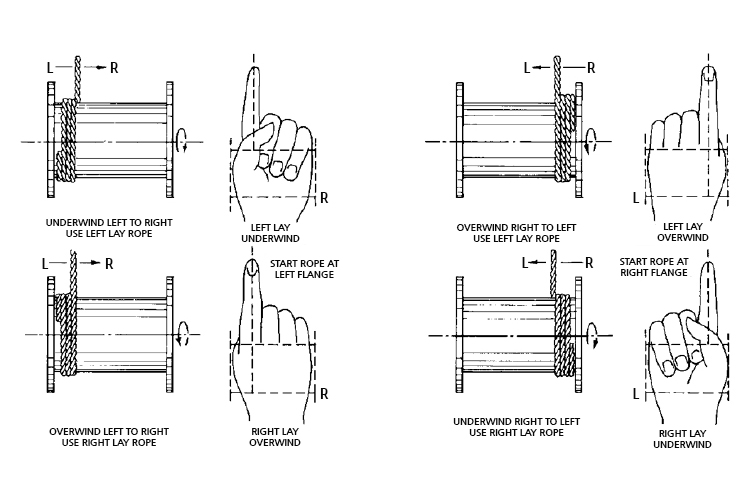
A simple method of determining how a wire rope should be started on a drum is shown in the above diagram. The observer stands behind the drum, with the rope coming towards him. Using the right hand for right-lay wire rope, and the left hand for left lay wire rope, the clenched fist denotes the drum, the extended index finger the oncoming rope.
Seizing Wire Rope
Proper seizing and cutting operations are not difficult to perform, and they ensure that the wire rope will meet the user’s performance expectations. Proper seizings must be applied on both sides of the place where the cut is to be made. In a wire rope, carelessly or inadequately seized ends may become distorted and flattened, and the strands may loosen. Subsequently, when the rope is operated, there may be an uneven distribution of loads to the strands; a condition that will significantly shorten the life of the rope.
Either of the following seizing methods is acceptable. Method No. 1 is usually used on wire ropes over one inch in diameter. Method No. 2 applies to ropes one inch and under.
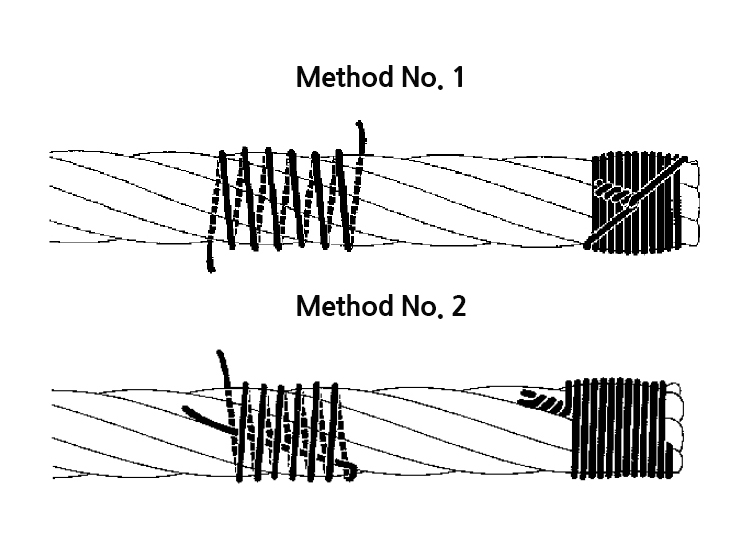
Method No. 1: Place one end of the seizing wire in the valley between two strands. Then turn its long end at right angles to the rope and closely and tightly wind the wire back over itself and the rope until the proper length of seizing has been applied. Twist the two ends of the wire together, and by alternately pulling and twisting, draw the seizing tight.
Method No. 2: Twist the two ends of the seizing wire together, alternately twisting and pulling until the proper tightness is achieved.
The Seizing Wire. The seizing wire should be soft or annealed wire or strand. Seizing wire diameter and the length of the seize will depend on the diameter of the wire rope. The length of the seizing should never be less than the diameter of the rope being seized.
Proper end seizing while cutting and installing, particularly on rotation- resistant ropes, is critical. Failure to adhere to simple precautionary measures may cause core slippage and loose strands, resulting in serious rope damage. Refer to the table for established guidelines. If core protrusion occurs beyond the outer strands, or core retraction within the outer strands, cut the rope flush to allow for proper seizing of both the core and outer strands.
In the absence of proper seizing wire or tools, the use of sufficiently- sized hose clamps is acceptable.
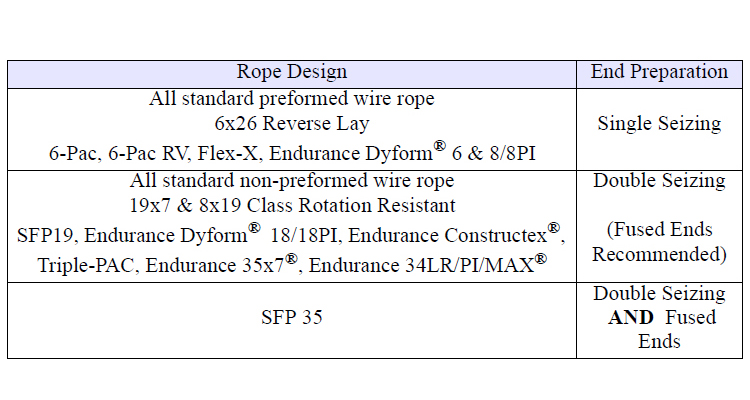
Installation
The majority of wire rope problems occurring during operation actually begin during installation, when the rope is at greatest risk of being damaged. Proper installation procedures are vital in the protection and performance of wire rope products.
• Provide Proper Storage- Avoid damage and moisture
• Check the Rope Diameter Prior to Installation
• Use Proper Unreeling/Uncoiling Procedures
• Keep the Wraps Tight
• Treat Rotation-Resistant Ropes with Extra Care
• Secure the Ends Before Cutting
• Use a Wire Mesh Grip or Chinese Finger (to Prevent Torque from the old rope transferring to the new rope)
• Always Perform a Break-In Procedure to Maximize Service Life
• Avoid Slack in the Rope
• Slowly Lift or Release the Load
• Use the Wire Rope ONLY for the Job it was Intended.








